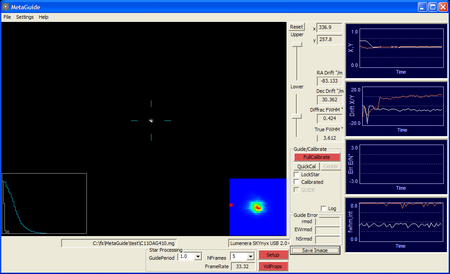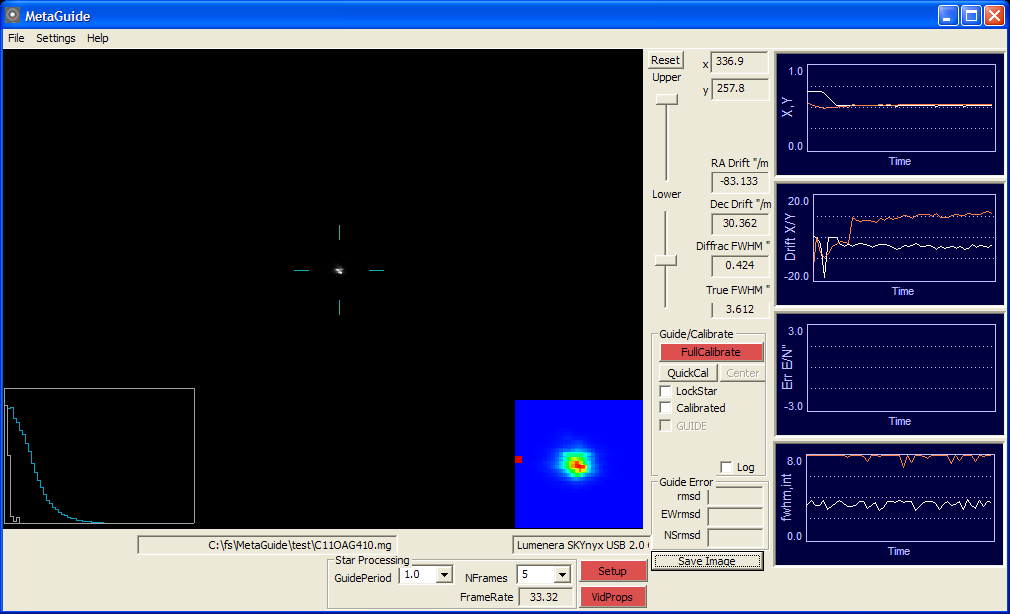MetaGuide v4.1.2 Portable | 4.7 MB
MetaGuide is a web-cam based tool for precise collimation of the in-focus diffraction pattern of a star. MetaGuide also autoguides and has several novel features that allow optimal guiding of mid-range mounts under typical seeing conditions. MetaGuide can provide insight into both the optics of your telescope, and the tracking behavior of your mount.
MetaGuide allows me to obtain 2" fwhm stars with a Celestron CGE and 11" SCT at 2800mm f.l. and 0.45" per pixel. The key is an accurate centroid that can be chased aggressively to overcome gearbox and bearing noise. This pushes autoguiding of a mid-range mount into a realm of performance that normally requires active-optics.
MetaGuide is free, easy to use, works with any type of telescope, and most web-cams.
MetaGuide has many unique features, such as realtime measurement of flexure between two telescopes. This allows direct observation and measurement of flexure and mirror flop. MetaGuide also has a novel proactive guiding feature that locks onto specific high frequency gearbox or gear tooth terms that can be more of an issue than periodic error. MetaGuide also uses a novel form of "Lucky" centroiding to help determine a more accurate centroid that can be guided aggressively.
MetaGuide is highly quantitative, and provides live measurements of the radial profile of a star and its full-width at half-maximum for comparison to diffraction theory. It also measures drift, to aid polar alignment.
Although based on video guiding, MetaGuide can stack frames to create an effectively long exposure that reaches faint guide stars. It also finds even faint guide stars in the field and highlights them automatically. This avoids the user having to squint at the screen to find a faint star and then select it
What does MetaGuide do?
* Allows a high power view of a star and its diffraction pattern even when seeing is bad
* Shows a "coma dot" over the live star that guides collimation by showing a sensitive view of coma due to misalignment. This takes the guesswork out of collimation while keeping it interactive and realtime
* Compares the observed diffraction pattern with theory, including secondary obstruction effects
* Provides a simple "dump" of the raw and steady images of the star, along with a plot that shows how the stellar profile compares to theory, plus numeric values for the actual and theoretical FWHM's. This provides an objective and quantitative measure of a telescopes true performance, with less dependence on good seeing
* Measures flexure/mirror flop using two telescopes, two web-cams, and two instances of MetaGuide that link to each other
* Automatically re-centers the telescope during collimation so you can concentrate on the collimation adjustments and not have to re-center manually after each change
* Acts as an autoguider with seeing effects partially removed from the error, so the "chasing of the seeing" is directly reduced
* Locks onto a user-specified error frequency and corrects for it proactively, acting like a new level of periodic error correction that does not rely on indexing and can work at higher frequencies
* Calculates centroid based on live view of stars using a very different algorithm than simple "center of gravity." To reach fainter stars, the frames may be stacked first for the effect of long exposures
* Provides graphical output and logs of drift and periodic error in your mount, including the "noise" that can be hard to remove with PEC (Periodic Error Correction).
How does it work?
* MetaGuide uses realtime image processing of the video stream to process each frame, find the star centroid, and output a realtime stacked version of the recent frames
* Bad frames are automatically culled from the stack without user intervention
* MetaGuide is written in DirectShow/C++ for maximum performance since the amount of realtime computation is significant
* The stacked view is magnified 4 times and aligned with sub-pixel resolution
* This stacked view is also used as to determine guide corrections. The centroid is not calculated with a simple center of gravity medthod. Since this view has bad frames removed, the resulting error signal is a truer representation of the error due to the mount. This reduces the "chasing of the seeing."
* The radial plot is calcluated based on the stacked image, allowing direct comparison to theory and calculation of FWHM
What are its requirements?
* MetaGuide requires only a web-cam and Windows Vista, XP or 2000 computer (not Win98, ME, NT, Mac, or Linux) with recent DirectX installed to perform the core diffraction analysis of a star
* Most web-cams are supported - as long as they can output a 640x480 format. Many high resolution web-cams also support this resolution, via binning or cropping. In addition, it has been tested with inexpensive video2usb converters, allowing most any video camera also to work
* Modified web-cams are not supported; MetaGuide relies on streaming video to correct for seeing
* For the guiding features of MetaGuide, an ASCOM connection, parallel port or USB guider cable is needed. The mount must be either equatorial or on a wedge, and for ASCOM it must support PulseGuide
* A view of the diffraction pattern requires high power and a stable mount, so a Barlow and good tracking may be needed. The guiding and collimation aspects of MetaGuide will work with any f/ratio
August 2009 version 4.1.2
* Much cleaner interface, with beginner and advanced modes
* Extensive new documentation available from the help menu
* Smaller screen size to fit NetBooks down to 1024x600
* Simplify the meridian flip process to avoid re-calibration
* New log output for the free EQMod PECPrep tool, for periodic error analysis
* Launch directly from an Icon and recover all session settings
* Dither the guide star location with the press of a button
* Remote control from scripts and applications such as Astro Art
* Readout of dec. drift for easy polar alignment with direct drift readout
* Many bug fixes and enhancements.
Homepage - http://www.astrogeeks.com/Bliss/MetaGuide/



